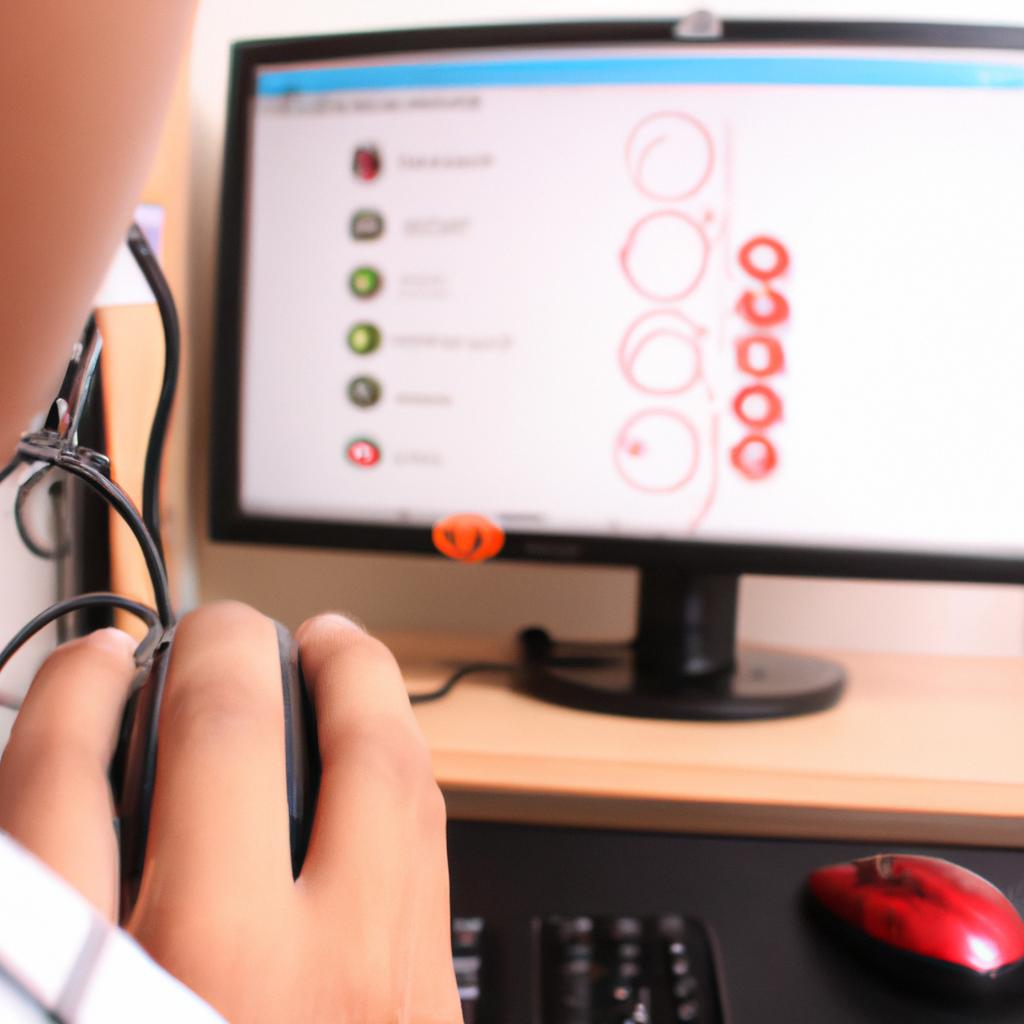Error Detection in Computer Data Communications: Ensuring Accurate Data Transmission

Data transmission plays a crucial role in computer communications, ensuring the accurate transfer of information between devices. However, errors can occur during this process due to various factors such as noise, interference, or hardware malfunctions. Detecting and correcting these errors is essential for maintaining data integrity and preventing communication breakdowns. In this article, we will explore different error detection techniques used in computer data communications, highlighting their importance in guaranteeing reliable and secure data transmission.
For instance, consider a scenario where an organization needs to transmit sensitive financial data from one location to another over a network connection. Any inaccuracies or corruptions in the transmitted data could have severe consequences for the organization’s operations and reputation. To mitigate such risks, error detection mechanisms are employed to identify and rectify any potential errors that may arise during the transmission process. By implementing robust error detection techniques, organizations can ensure the accuracy and reliability of their important data transfers.
In the following sections, we will delve into various error detection methods commonly utilized in computer data communications. These methods range from simple parity checks to more sophisticated checksum algorithms and cyclic redundancy checks (CRC). We will discuss how each technique operates, examining their strengths and limitations in detecting errors effectively while minimizing overhead costs. Furthermore, we will explore real-world applications of these error detection techniques, such as in network protocols like Ethernet and Wi-Fi, where they play a vital role in ensuring reliable data transmission.
One real-world application of error detection techniques is in the transmission of digital audio and video signals. When streaming media over networks or broadcasting signals over television channels, errors can occur due to channel noise or signal interference. Error detection methods such as CRC are used to ensure that the received audio or video data matches the original source, preventing distortions or loss of quality.
Another example is in wireless communication systems like Bluetooth or cellular networks. These systems often operate in environments with high levels of radio frequency interference, which can introduce errors during data transmission. Error detection mechanisms are employed to detect and correct any errors introduced by these external factors, enabling seamless communication between devices.
In addition to transmission errors, error detection techniques also find applications in storage systems like hard drives and solid-state drives (SSDs). These storage devices use error correction codes (ECC) to detect and correct errors that may occur when reading or writing data. By employing sophisticated ECC algorithms, these storage systems can ensure the integrity and reliability of stored data, reducing the risk of data corruption or loss.
Overall, error detection techniques are essential for maintaining the accuracy and reliability of computer communications. Whether it’s transmitting financial data, streaming media content, or storing important information, implementing robust error detection mechanisms is crucial for safeguarding against potential errors and ensuring seamless data transfer.
Types of errors in computer data communications
Types of Errors in Computer Data Communications
Introduction
Imagine a scenario where an individual is sending an important document to their colleague via email. However, upon receiving the file, they discover that some portions are missing or distorted. This lapse in accurate data transmission can be attributed to errors that occur during computer data communications. Understanding these types of errors is crucial for ensuring reliable and error-free communication across various networks.
Signposts: The Importance of Error Detection
To comprehend the significance of error detection, consider the following example: A financial institution relies on secure connections to transfer sensitive customer information between branches. If errors go undetected during this process, it could lead to incorrect transactions or compromised data integrity. Thus, being aware of the different types of errors and employing effective error detection techniques becomes essential.
- Errors can result from signal interference caused by electromagnetic noise.
- Transmission medium issues such as attenuation and distortion also contribute to errors.
- Faulty hardware components within network devices may introduce errors into the system.
- Software glitches or coding mistakes can cause data corruption during transmission.
Table: Types of Errors in Computer Data Communications
| Type of Error | Cause | Impact |
|---|---|---|
| Signal Interference | Electromagnetic noise | Distorted or lost data |
| Transmission Medium | Attenuation (signal weakening) | Incomplete or degraded data |
| Issues | Distortion (changes in signal shape) | Altered data |
| Hardware Failures | Malfunctioning network equipment | Intermittent connectivity or corrupted data |
Transitions: Common Error Detection Techniques
By gaining insight into these diverse sources of errors, we can explore common error detection techniques that help mitigate them effectively. These methods aim to ensure accurate and reliable transmission by identifying and correcting errors before they impact the integrity and authenticity of data.
Common error detection techniques
Imagine a scenario where you are sending an important email containing critical information to your colleague. You hit the send button, confident that your message will reach its destination intact and error-free. However, during transmission, various factors can introduce errors into the data being sent. In this section, we will explore some common techniques used in computer data communications to detect these errors and ensure accurate data transmission.
Error Detection Techniques:
-
Checksums: One widely-used technique for error detection is the checksum method. A checksum is a small piece of data calculated from the entire set of transmitted data, including both the payload and control bits. This value acts as a “fingerprint” of sorts, allowing the recipient to verify if any errors have occurred during transmission. By comparing the received checksum with a recalculated checksum at the receiving end, potential errors can be detected.
-
Cyclic Redundancy Check (CRC): CRC is another effective error detection method commonly employed in computer networks and storage systems. It utilizes polynomial division operations to generate check values that are appended to the transmitted data stream. At the receiver’s end, calculations are performed using these check values to determine if any errors have occurred during transmission.
-
Hamming Code: Developed by Richard Hamming in 1950, Hamming codes provide a more robust means of error detection and correction compared to other methods mentioned earlier. These codes involve adding redundant bits within each block of transmitted data so that errors can be identified and corrected on-the-fly at the receiving end.
- Ensuring reliable communication between devices
- Safeguarding sensitive information from corruption or loss
- Minimizing costly retransmissions due to undetected errors
- Enhancing user experience through seamless data transfer
Table showcasing different error detection techniques:
| Technique | Description | Advantages |
|---|---|---|
| Checksums | Calculates a checksum from transmitted data to detect errors | Simple implementation, low computational cost |
| CRC | Utilizes polynomial division operations to generate check values for error detection | High accuracy in detecting different types of errors |
| Hamming Code | Adds redundant bits within each block of data to identify and correct errors on-the-fly | Robust error detection and correction mechanism |
Having explored the various techniques used for error detection in computer data communications, let us now delve into one specific method: the parity bit. We will examine its role in ensuring accurate transmission and mitigating potential errors.
Parity bit and its role in error detection
Error detection is a crucial aspect of computer data communications, ensuring the accurate transmission of information. In the previous section, we examined some common error detection techniques used in this field. Now, let us delve deeper into one specific technique: the parity bit and its role in detecting errors.
To illustrate the importance of error detection, consider a hypothetical scenario where an online shopping platform receives an order for a laptop. The customer’s address details are recorded and transmitted to the shipping company. However, during transmission, noise interference corrupts some bits of the data. Without proper error detection mechanisms in place, these corrupted bits may go unnoticed, leading to incorrect delivery or even loss of valuable merchandise.
One commonly employed method for error detection is the use of parity bits. A parity bit is an additional bit added to a binary code sequence as a means of verifying its accuracy. It works by calculating whether the number of 1s within a given set of bits is odd or even. By comparing this calculated value with the received message’s parity bit, any discrepancies can be detected and flagged as potential errors.
The role of parity bits in error detection can be summarized through the following key points:
- Parity bits provide a simple yet effective way to detect single-bit errors.
- They help identify when noise or other factors have altered the integrity of transmitted data.
- When combined with appropriate algorithms and protocols, parity checks can significantly enhance overall system reliability and ensure accurate data transmission.
By understanding the fundamentals behind common error detection techniques like using parity bits, researchers and engineers can develop robust systems that minimize data corruption risks while enhancing overall communication efficiency.
Moving forward, our exploration will now shift towards discussing checksum algorithms for detecting errors in computer data communications without compromising performance and speed.
Checksum algorithms for detecting errors
Error detection plays a crucial role in computer data communications, ensuring the accuracy of transmitted data. After discussing the use of parity bit as an error detection mechanism in the previous section, we will now explore another method known as checksum algorithms.
Checksum algorithms involve the calculation of a sum or hash value from the data being transmitted and appending it to the message. This allows for quick verification at the receiving end by recalculating the checksum and comparing it with the received value. If they match, it indicates that no errors were introduced during transmission; otherwise, an error is detected. One commonly used algorithm is Internet Checksum (RFC 1071), which operates on blocks of data using binary ones’ complement arithmetic.
To illustrate how checksum algorithms work, let’s consider a hypothetical scenario where a large file is being transferred over a network connection. In this case, each block of data would have its own calculated checksum appended to it. At the receiving end, these individual checksums are verified against their respective blocks to ensure accurate transfer. The following bullet point list highlights key aspects:
- Checksum algorithms provide an additional layer of protection against errors.
- They can detect single-bit errors as well as some multiple-bit errors.
- However, they cannot correct errors once identified; retransmission may be necessary.
- Different checksum algorithms exist depending on specific requirements and trade-offs.
Table: Comparison of Common Checksum Algorithms
| Algorithm | Description | Advantages |
|---|---|---|
| Internet | Used widely in networking | Simplicity, efficiency |
| Adler32 | Efficient for small files | Fast computation |
| CRC | Commonly used in storage media | High error-detection capabilities |
In summary, checksum algorithms serve as effective error detection mechanisms in computer data communications. By calculating and verifying checksum values associated with transmitted data, these methods enhance reliability and help ensure accurate transmission. In the subsequent section, we will delve into another widely used error detection technique known as the Cyclic Redundancy Check (CRC) method.
Cyclic redundancy check (CRC) method
Error detection is a critical aspect of computer data communications, ensuring the accuracy and integrity of transmitted data. In addition to checksum algorithms, another commonly used method for error detection is the cyclic redundancy check (CRC). This section will explore CRC in detail, highlighting its advantages and limitations.
To illustrate the importance of CRC, consider an example where a company sends large volumes of financial data over a network connection to their remote offices. If errors were introduced during transmission due to noise or interference, it could result in inaccurate financial records and potentially lead to costly mistakes. By implementing CRC as an error detection mechanism, this company can enhance the reliability of their data transfers.
One advantage of using the CRC method is its ability to detect both single-bit errors and burst errors more effectively than some other techniques. The calculation involves generating a remainder polynomial based on the transmitted message and comparing it with a predefined divisor polynomial at the receiver’s end. If any discrepancy is detected between these two polynomials, an error flag is raised, indicating that there has been a transmission error.
In order to better understand the benefits of employing CRC for error detection, let us consider four key points:
- Efficiency: The CRC process provides efficient error detection capabilities without significantly impacting the overall performance of the system.
- Versatility: It can be applied across various communication protocols and media types, making it highly adaptable in different scenarios.
- Reliability: By incorporating robust mathematical calculations into the algorithm design, CRC offers reliable error detection even under challenging conditions.
- Ease of Implementation: Implementing CRC does not require extensive computational resources or complex coding structures; thus, it can be easily integrated into existing systems.
The table below summarizes some important features and considerations related to CRC:
| Features | Considerations |
|---|---|
| Error Detection | Detects most common types of errors |
| Data Integrity | Ensures accurate transmission of data |
| Performance | Has minimal impact on system performance |
| Error Correction | CRC is primarily used for error detection, not correction |
Moving forward, the subsequent section will delve into another category of error control techniques known as Forward Error Correction (FEC) methods. These techniques differ from error detection mechanisms like CRC in that they involve the transmission of additional redundant information to enable the receiver to correct errors automatically without retransmission.
By exploring FEC techniques, we can gain a comprehensive understanding of how various strategies can be employed to ensure accurate and reliable data communication.
Forward error correction (FEC) techniques
Section H2: Reed-Solomon Codes for Error Detection
To further enhance error detection capabilities in computer data communications, the Reed-Solomon codes have been widely adopted. These codes are particularly effective in correcting errors that occur during transmission over noisy channels. For instance, consider a hypothetical scenario where Company X is transmitting important financial data to its clients through an unreliable communication channel. Implementing Reed-Solomon codes can help ensure accurate and reliable data transmission.
Reed-Solomon codes offer several advantages when it comes to error detection and correction:
- High error detection capability: These codes can detect multiple errors within a block of transmitted data, enabling efficient identification and rectification.
- Robustness against burst errors: Burst errors refer to consecutive bit or symbol errors occurring within a short period of time. Reed-Solomon codes excel at detecting such patterns and allowing for their recovery.
- Scalability to different data sizes: Unlike some other error detection techniques, Reed-Solomon codes can be applied to various data sizes without compromising accuracy or efficiency.
- Flexibility across different applications: Due to their versatility, these codes find application in diverse domains including telecommunications, storage systems, satellite communications, digital broadcasting, and more.
The effectiveness of employing Reed-Solomon codes can be demonstrated by comparing the performance metrics with alternative methods. The following table showcases the comparison between three commonly used error detection techniques – CRC method from the previous section, Hamming code, and Reed-Solomon code:
| Technique | Bit Error Rate | Burst Error | Data Size Flexibility |
|---|---|---|---|
| CRC | Moderate | Sensitive | Limited |
| Hamming Code | High | Sensitive | Restricted |
| Reed-Solomon Code | Low | Resilient | Versatile |
As evident from the table, Reed-Solomon codes outperform both CRC and Hamming code in terms of bit error rate, robustness against burst errors, and data size flexibility. These factors make them a preferred choice for ensuring accurate data transmission over unreliable communication channels.
In summary, the Reed-Solomon codes provide an effective means for detecting errors during computer data communications. Their high error detection capability, resilience against burst errors, scalability to different data sizes, and versatility across various applications make them a valuable tool in maintaining reliable data transmission. Employing these codes can significantly enhance the overall accuracy and integrity of transmitted information.






